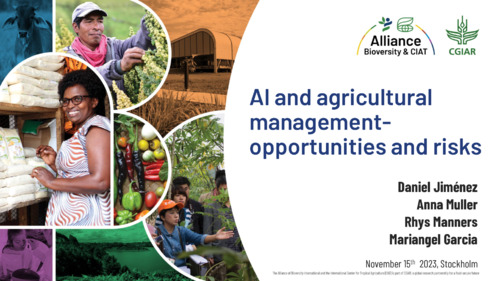Artificial intelligence and agricultural management: Opportunities and risks
The integration of AI in agricultural management presents a world of opportunities and challenges. We have explored various aspects, from addressing inadequate information and limited capabilities to bridging the digital divide and concerns about job displacement. As we navigate this transformative journey, it is essential to prioritize the user, embrace human-centered design, and ensure that AI-powered solutions are not only feasible but also sustainable for farmers in diverse regions.
Moreover, it's vital to recognize the potential of AI to enhance human capacity and improve efficiency rather than solely replacing jobs. Collaboration, open access to information, and co-creation with educational institutions are crucial steps in preparing agricultural professionals for the future. By embracing these opportunities and addressing the associated risks, we can harness the power of AI to accelerate the inclusive and sustainable transformation of agricultural systems, benefiting both farmers and our global food security.
1. AI in Agricultural Management: Opportunities and Risks
2. Addressing Inadequate Information:
• AI-driven diagnostic and descriptive analytics offer solutions for providing site-specific agronomic recommendations.
• Potential to reduce excessive use of agrichemicals and promote sustainable practices.
• Risks include the feasibility and environmental impact of recommendations.
3. Ensuring Socio-Economic Inclusivity:
• The challenge of reaching farmers with low literacy and no internet access.
• Emphasize human-centered design in product development.
• Highlight the need for accessible communication channels.
4. Improving Generative AI Algorithms:
• Highlight the risk of AI model hallucinations.
• Discuss technologies like Microsoft's CHAT that allow users to control model creativity.
• Stress the role of organizations like CGIAR in enhancing AI models through open access, data quality, and standardization.
5. Overcoming Limited Capabilities:
• Discuss the challenge of monitoring diets with traditional methods.
• Introduce the high-frequency phone survey system for improved data collection.
• Mention the impact of unexpected challenges in scaling this system.
6. Bridging the Digital Divide:
• Emphasize the importance of user-centered innovation.
• Explain the use of AI-based frameworks to identify effective communication channels.
• Highlight low digital tool usage rates in Latin America, Asia, and Africa.
7. AI Enhancing Human Capacity:
• Present the example of using AI to identify insects in sugarcane traps.
• Stress the potential for AI to enhance efficiency rather than replace jobs.
8. Addressing Limited Capabilities:
• Discuss the identified knowledge and skills gaps among agricultural professionals in the developing world.
• Emphasize the need for education on ICT tools, data analytics, climate change, and more.
9. Co-Creating Curricula:
• Highlight the importance of co-creating curricula with educational institutions.
• Mention the development of undergraduate programs, diploma courses, and certifications focusing on AI, data management, human-centered design, and agricultural entrepreneurship.
10. Future Prospects:
• Conclude by mentioning the establishment of Guatemala's digital agricultural plot for sustainable food production.
• Highlight the ongoing efforts to empower agricultural professionals for the future

